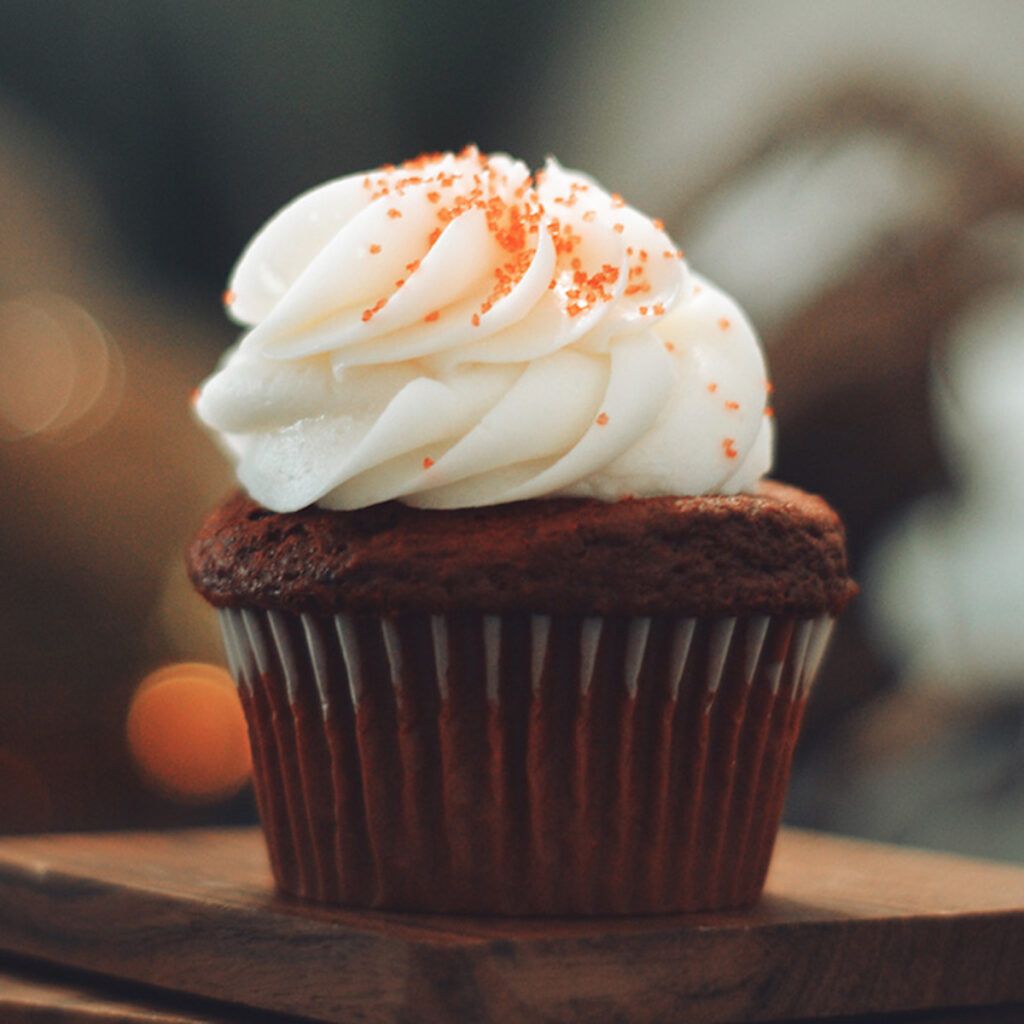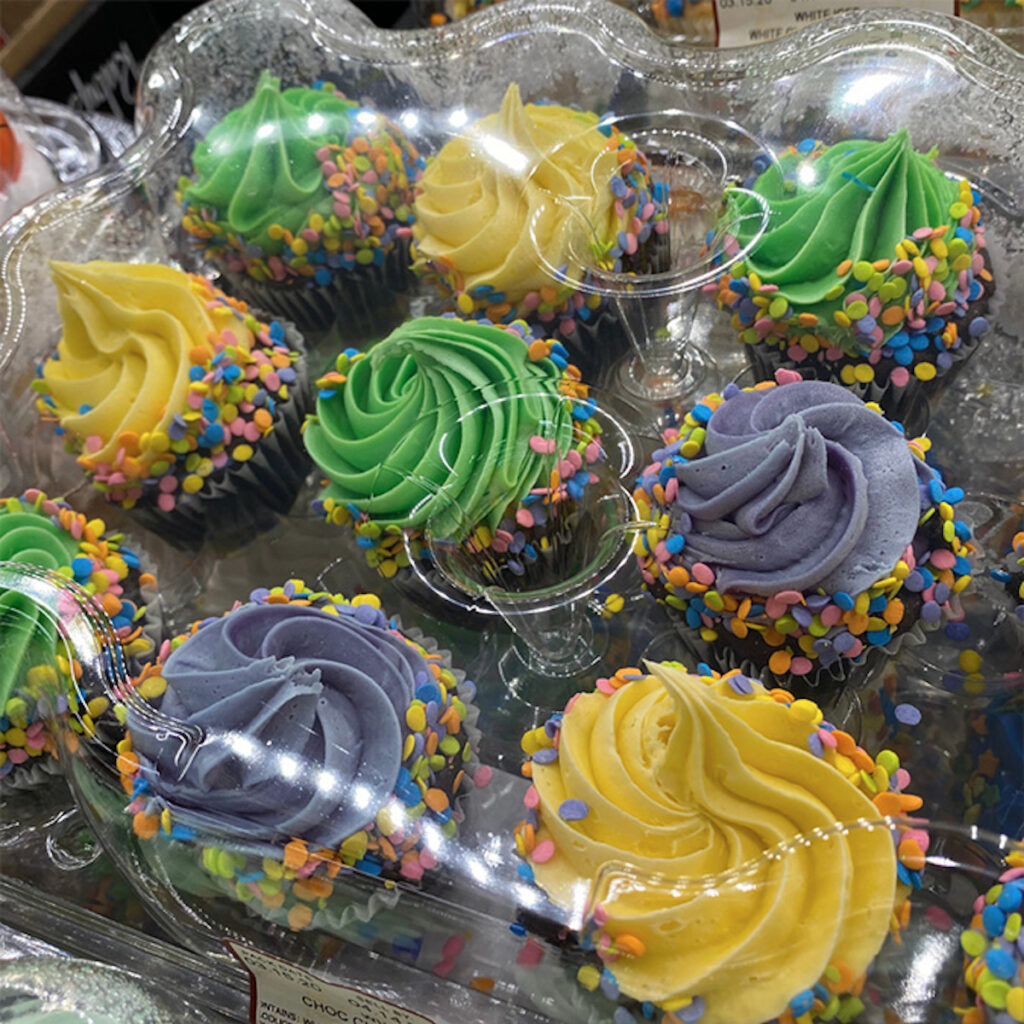If you’re wondering what to do to make leftover cupcakes last (because throwing an old cupcake away is a travesty, right?!?) or preparing cupcakes in advance of a special occasion, here’s everything you need to know about how long cupcakes are good for.

How Do Cupcakes Go Bad?
Most foods go bad, that’s sadly how life is. Extending the shelf life of cupcakes begins with understanding how the parts of a cupcake get ‘old’ or ‘goes bad’ and then taking steps to prevent it as long as possible.
The cake, frosting, and any perishable toppings or fillers all have their own shelf life before going bad.
Loss of moisture
The best cupcakes aren’t just about the flavor – the texture is important too. The ‘moistness’ of a cupcake comes from both its water and oil content.
Water evaporates much faster than oil – that’s science 101.
A cupcake will stay moist longer in a humid climate than a dry climate, but how long exactly depends on the type of cupcake and its moisture content as much as local humidity levels. If you live in a very dry place, you can expect the moisture to evaporate a bit quicker than in other places.
Both the cake and the frosting of the cupcake can dry out overnight if either has low water content and the air is very dry or could last a couple of days with a higher oil or water content, or if the air is less dry.
The cake part of the cupcake gets hard, crumbly, or ‘chalky’ as it loses moisture. The frosting or icing will harden as it loses moisture. These are not very nice qualities in cupcakes, are they?
Rotting and food poisoning

Any food can become infected by microorganisms, which are naturally present in the air (molds), may be already present in an ingredient, or can be transmitted by contact with a contaminated object. There’s also the risk of cross-contamination, which happens when surfaces such as cutting boards and cooking tools are not properly sanitized when managing different ingredients, such as egg or chicken.
Bacteria and viruses that cause food poisoning
According to the CDC, “The top five germs that cause illnesses from food eaten in the United States are:
- Norovirus
- Salmonella
- Clostridium perfringens
- Campylobacter
- Stappylococcus aureus
Some other germs don’t cause as many illnesses, but when they do, the illnesses are more likely to lead to hospitalization. Those germs include:
- E. coli
- Clostridium botulinum (botulism)
- Listeria
- E. coli
- Vibrio”
Some of these, like salmonella, are carried by farm animals without making them sick but get transmitted by way of their products like eggs and milk.
Cake frostings with dairy products
- cream cheese frosting
- buttercream frosting
- whipped cream frosting
- custard frostings (also have egg yolk)
- royal frosting (also has egg white)
- icing and glazes typically use milk as their liquid component
The good news is that these organisms will die when the cupcakes are baked. What you want to watch out for is transmitting a germ from a cake ingredient to a frosting ingredient since frostings and icings are not cooked.
The best thing you can do to prevent food poisoning while baking cupcakes is to wash your hands before you begin. It’s also a good idea to clean your hands and the kitchen area you are using between baking the cupcakes and decorating them, and any time you’re touching other foods in order to prevent cross-contamination.
Boxed cake mixes call for the addition of eggs, and most cake recipes use eggs as well. If you’re looking for a cake recipe without eggs to avoid any kind of risk, vegan cupcakes are your best bet.
Mold
Mold is a fungus that grows on food and makes it rot by breaking down the nutrients from the food it is growing on and leaving only the waste products. When you see greenish, white, or gray ‘fuzz’, on old food, it’s mold.
Food molds only very rarely make people sick. Though you might feel nauseous if you unknowingly bite into a moldy cupcake – it tastes gross and just the thought of it can turn the stomach. In general, it is recommended to throw away any foods that have mold in them – who would want to eat them anyway?!
Going rancid
Oxidation is a chemical process that alters the properties of cupcake ingredients, making them taste bad. When this happens, the oil (or the food) is referred to as ‘rancid’.
Have you noticed how the open surface of a sliced apple, avocado, or potato turns brown within hours? This is from the chemical reaction between the oxygen in the air and the exposed chemicals from the inside of the fruit.
Technically a reaction that loses an electron is called an oxidation reaction, but the most common way this occurs naturally is when an oxygen atom from the air combines with another molecule, hence the name ‘oxidation’.
This occurs in our bodies too, which is why fruits and vegetables that contain anti-‘oxidant’ or anti-oxidation properties are considered healthier than others.
In general, oils are much more likely to go rancid before evaporating, but for a cupcake, the cupcake will probably be taken over by mold long before the oil in it will turn rancid.
How Long Do Cupcakes Last?

At normal room temperature, a plain unfrosted cupcake will usually last a couple of days, or up to a week in the refrigerator.
Homemade cupcakes can be kept for a long time in an airtight container in the freezer – up to 3 to 6 months.
In general, it is a good idea to keep any baked treats in a high-quality, airtight container in order to preserve all the flavors – and to avoid unpleasant smells and flavors from the fridge.
What about cupcakes you buy from a store?
The best way to know how long these cupcakes are good for is simply by checking the expiration date on the packaging. They can be preserved just like homemade cupcakes.
How To Store Cupcakes To Keep Them Fresh
For best results, choose the freshest ingredients, keep them and your cooking space clean, and minimize exposure to the air and microbes after baking and while storing.
Choosing cupcake ingredients
There is one thing that is very important when baking or cooking anything: Once one ingredient is expired, then the whole cupcake is expired too!
When you are shopping, check every ingredient. Flour, sugar, milk, eggs, oil… all the way to the toppings including the food coloring, cream or fruit fillings, fresh fruit, and yes, even the sprinkles. You don’t want to risk getting yourself, your family, or all the guests at a birthday party feeling sick!
Fresh fruit and tree nuts that you scoop and bag yourself don’t typically have expiration dates on them, it’s up to you to choose the freshest ones you can. Packaged nuts do, and you can often find packaged nuts that haven’t been salted, roasted, or processed.
Baking cupcakes
A little planning before you bake can help too.
Baking the cupcakes (or any type of food) as close to the time you serve them is the freshest of course, but this isn’t always possible. For special occasions, you might even be making the cupcakes a day or two in advance. Either way, these steps will help your cupcakes stay super fresh.
Use cupcake liners when you bake cupcakes
Cupcake liners reduce the exposure to air and provide a surface you can touch while serving or decorating without coming into direct contact with the plain cupcake. Paper cupcake liners are more permeable to air than foil cupcake liners.
Cool the cupcakes quickly
Not everyone has large spacious refrigerators with room for cupcake pans to cool like you see on the baking shows, but if you do, great!
Using a cooling rack when you bake cupcakes accelerates cooling because of the airflow underneath.
Be sure and place cupcakes out of direct sunlight. Even through a window, the sun can warm up a cupcake and even melt the frosting.
Frost cupcakes as soon as they are cool and then store them immediately.
Storing Cupcakes

Whether you intend to eat them in a day, a week, or a month, the best cupcake storage is a sealed container to keep them from drying out.
On the counter
At the very least, cover the fresh cupcakes with plastic wrap or aluminum foil.
Next best is a closed container, the more airtight the better.
In the refrigerator
Cold temperatures slow down the processes that make a cupcake old. Chemical reactions like oxidation and biological processes like the reproduction of molds, bacteria, and viruses all slow down the cooler it gets, and typically halt entirely in freezing temperatures.
However, because most refrigerators and freezers also act to reduce humidity, cupcakes will often get dryer faster than cupcakes left on the counter.
Because of this, using a sealed container is best, followed by unsealed, then covered, then bare naked cupcakes on a plate that might get dry or pick up odd flavors from other poorly sealed items. If your fridge smells a little like those leftover onions, your cupcakes will too after a while.
When you take the cold cupcakes out of the fridge, be aware that the frosting will have a thicker, denser consistency to it and take longer to warm up again than the cake itself.
In the freezer
Freezing cupcakes will help them stay fresh for the longest period of time. Like refrigerators, most modern freezers also have a dehumidifying capability to help reduce frost buildup.
But it’s important to note that even frozen cupcakes can lose moisture while sitting in the freezer for months. When food or parts of food completely dehydrate in the freezer, it’s called ‘freezer burn. Freezer burned food won’t make you sick, but the changes to the flavor and texture are unpleasant to most people. Besides, make sure to only defrost a cupcake if you are intending to eat it soon – and don’t freeze it again afterward!
Plastic food storage bags are not completely airtight, even when they can hold water without leaking. Over time, air molecules can cross over. Freezer bags are thicker to help protect frozen food from freezer burn.
One more thing…
When you are thawing cupcakes, be aware they can collect condensation just like the side of the glass of a cold drink on a hot day. This can ruin frozen decorative frosting or make colors run, so be sure to keep them in a dry place.
Fun Facts About Cupcakes
- National Cupcake Day is December 15th!
- The first mention of the description of a cupcake can be traced back to 1796 in a recipe written by Amelia Simmons in American Cookery.
- The record for eating the most cupcakes in the shortest amount of time is 29 cupcakes in 30 seconds. That’s almost a cupcake per second!
- Cupcakes gained more popularity in the early 2000s when Sex and the City featured cupcake shops, like Magnolia Bakery.
- Until the 1920s, cupcakes were not decorated with frosting. Nowadays you can find frosting in pretty much every flavor.
